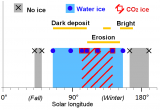Recent Martian flows: which contribution from carbon dioxide ice and water?
Ongoing flow activity was highlighted a few years ago on Mars by high-resolution cameras. Various flow types have been identified (new channels, dark lineae, bright deposits…) but there is still no consensus about possible formation mechanisms: dry avalanche? liquid water? carbon dioxide ice? A study conducted at the Institut d’Astrophysique Spatiale reveals for the first time the composition of winter ice forming in association with flows. Results suggest the coexistence of several current formation mechanisms.
While a recent study suggests the possible presence of liquid water on some dark flows observed on warm slopes, most current flows are observed on cold areas where ice forms during winter. These flows are currently explained by CO2 ice-based formation mechanisms, with no liquid water.
A study conducted at the Institut d’Astrophysique Spatiale provides for the first time the composition of snow and ice that form near these flows. Carbon dioxide ice is indeed observed with many flows, in particular those leading to the incision of new channels. However, other flows occurred where the observed winter ice is only composed of water. This finding shows that both CO2 and water ice-based formation mechanisms are currently contributing to flow activity on Mars.
Research paper:
Vincendon, M. (2015), Identification of Mars gully activity types associated with ice composition, J. Geophys. Res. Planets, 120, doi:10.1002/2015JE004909
Contact at IAS : Mathieu Vincendon, mathieu.vincendon @ ias.u-psud.fr
The various flows and modifications observed on a Mars crater slope during fall and winter are compared to formation and sublimation timeframes of water and CO2 ices and snows.
[[{"type":"media","view_mode":"media_responsive","fid":"474","attributes":{"alt":"","class":"media-image","height":"560","typeof":"foaf:Image","width":"840"}}]]




